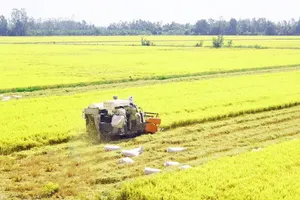
This issues was discussed at a workshop entitled “Pro-poor Rural and Agriculture Finance Best Practices: Experiences of Vietnam” held by the Vietnam Bank for Social Policies (VBSP), the Asia-Pacific Rural and Agriculture Credit Association and the International Fund for Agriculture Development in Hanoi on September 5.
Dao Minh Tu, Deputy Governor of the State Bank of Vietnam (SBV), told the workshop that the Party, the Government and the banking sector have always paid special attention to finance for farming areas in Vietnam.
Under the national target programme on sustainable poverty reduction, the VBSP was assigned to provide credit for poor households and social assistance beneficiaries.
In addition, the Government and the SBV have directed preferential credit programmes for agriculture and countryside areas in domestic credit institutions, he said.
Since 2006, credit programmes of the banking sector for agriculture, rural areas and the poor have been a key part of Vietnam’s poverty reduction policies.
“Therefore, the credit from the banking sector and other sources has helped Vietnam achieve the Millennium Development Goals (MDGs) in hunger elimination and poverty reduction in 2002, 13 years earlier than the target,” Tu said.
Over the years, the SBV has instructed credit institutions to balance their capital to meet the demand of farming, and regulate interest rate ceilings on short-term loans to priority sectors. The interest is currently at 6.5 percent per annum, 1 to 2 percent lower than the general interest rate.
The SBV has advised the Government on the issuance of credit support programmes for agriculture and rural development.
It has also directed credit institutions to implement programmes, polices and credit products to boost access to bank capital for people working in agriculture and rural development.
As a result, credit outstanding for agriculture and rural areas has increased by an annual average of 20 percent, higher than the overall credit growth of the economy, Tu said. Agricultural and countryside credit programmes have aided agricultural and rural development and farmers’ living standards.
Credit institutions have diversified banking products and services for farmers. Notably, the poor in remote areas have had opportunities to access financial products and services at a reasonable cost.
The VBSP has provided 20 credit programmes for agriculture and countryside areas, including lending for the poor and near poor, according to the bank. In the first half of this year, the bank’s total outstanding loans stood at 181.8 trillion VND (7.75 billion USD), 90 percent for agriculture and the rural areas.
Tran Huu Y, director of the training centre of the VBSP, said the bank’s development strategy by 2020 approved by the Prime Minister has set forth orientations that firstly target customers’ financial sustainability.
Duong Quyet Thang, VBSP General Director, said the bank has contributed to reducing poverty, improving farmers’ living standards, narrowing income gap and raising the poor’s awareness of saving.
However, Deputy General Director of the Vietnam Bank for Agriculture and Rural Development (Agribank) Nguyen Thi Phuong said investment in rural agriculture has been limited and not met demand. Private investment has been small, with few enterprises operating in the agricultural sector, most of which are small-scale.
In addition, agricultural production is often affected by natural disasters, climate, diseases, environmental pollution and climate change.
Agribank has proposed increased investment in farming, especially from the State budget, for infrastructure, science and technology as well as input products.
In addition, the ability of credit organisations providing financial services for non-urban areas should be strengthened to ensure safety, efficiency and responsibility in operation, especially for VBSP and Agribank which are major loan providers for agriculture and rural areas.
Nguyen Quoc Hung, head of the Credit Department under the SBV, said the central bank will continue to identify agricultural and rural areas as priorities, adding that it will use monetary policy management tools to provide capital support for credit institutions in order to increase loans in service of agriculture and rural areas.
At the same time, the bank will instruct credit institutions to step up administrative reforms, simplify lending procedures, and diversify products and services in an effort to increase the access to loans of customers in the field of agriculture and rural areas, he said.
























